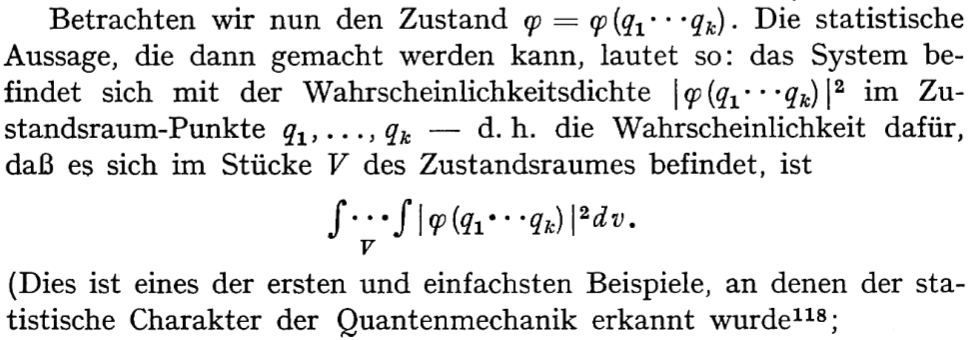nLab Born rule
Context
Quantum systems
-
quantum algorithms:
Probability theory
Measure theory
Probability theory
Information geometry
Thermodynamics
Theorems
Applications
Contents
Idea
The Born rule is the core statement of coordination in the foundations of quantum physics:
In its version for pure states the Born rule says that
-
for an observable in the form of a Hermitean operator on the given Hilbert space of pure quantum states with Hermitian inner product
-
denoting the projection operator on a given eigenstate of this operator,
-
a pure state;
then the probability of observing the given eigenstate in a quantum system which is in state equals (in bra-ket notation):
In particular, if is an orthonormal basis for the Hilbert space of states associated with a quantum measurement-procedure, then the probability of measuring the result on a system in state is
and so if the state is normalized to begin with ( = 1 ), then the probability is
Essentially in this form the rule was first formulated by Born 1926b p 805.
Related concepts
References
Historical origins
The Born rule is named in honor of
- Max Born, Zur Quantenmechanik der Stoßvorgänge, Zeitschrift für Physik 37 (1926) 863–867 [doi:10.1007/BF01397477]
where it appears (though disregarding the norm symbol) as a brief footnote-added-in-proof:

and its expanded version
- Max Born, Quantenmechanik der Stoßvorgänge, Zeitschrift für Physik 38 (1926) 803–827 [doi:10.1007/BF01397184]
which provides the mathematical details (p. 805):

and finally in the followup
- Max Born, Das Adiabatenprinzip in der Quantenmechanik, Zeitschrift für Physik 40 (1927) 167–192 [doi:10.1007/BF01400360]
which makes the interpretation more explicit (p. 171):

The generalization of this idea to probability densities for continuous observables is due to Wolfgang Pauli, as first recounted in:
- Pascual Jordan, Über eine neue Begründung der Quantenmechanik, Zeitschrift für Physik 40 (1927) 809–838 [doi:10.1007/BF01390903]

and then by Pauli himself, again in a footnote:
- Wolfgang Pauli, Über Gasentartung und Paramagnetismus, Zeitschrift für Physik: A Hadrons and nuclei 41 (1927) 81–102 [doi:10.1007/BF01391920]

Early review of the Born-Pauli rule:
- David Hilbert, John von Neumann, Lothar W. Nordheim, Über die Grundlagen der Quantenmechanik, Math. Ann. 98 (1928) 1–30 [doi:10.1007/BF01451579]
where it is once again a footnote:

and in
- Paul A. M. Dirac, The physical interpretation of the quantum dynamics, Proceedings of the Royal Society of London 113 765 (1927) [doi:10.1098/rspa.1927.0012]

The full recognition and amplification of the Born rule as a pillar of quantum physics making it a probabilistic theory (cf. quantum probability) is (maybe besides Jordan 1927) due to:
-
John von Neumann, Die quantenmechanische Statistik, Part III in:
Mathematische Grundlagen der Quantenmechanik, Springer (1932, 1971) [doi:10.1007/978-3-642-96048-2]
Mathematical Foundations of Quantum Mechanics Princeton University Press (1955) [doi:10.1515/9781400889921, Wikipedia entry]


Historical survey:
- Jagdish Mehra, Helmut Rechenberg, The Probability Interpretation and the Statistical Transformation Theory, the Physical Interpretation, and the Empirical and Mathematical Foundations of Quantum Mechanics 1926-1932, Part 1 in: The Historical Development of Quantum Theory. Volume 6: The Completion of Quantum Mechanics, 1926-1941, Springer (2001) [ISBN:978-0-387-98971-6]
Further discussion
Review:
-
Klaas Landsman, The Born rule and its interpretation, in: Compendium of Quantum Physics, Springer (2009) 64-70 [doi:10.1007/978-3-540-70626-7_20, pdf, pdf]
-
Arnold Neumaier: The Born rule – 100 years ago and today [arXiv:2502.08545]
See also:
- Wikipedia, Born rule
Last revised on February 14, 2025 at 08:46:21. See the history of this page for a list of all contributions to it.